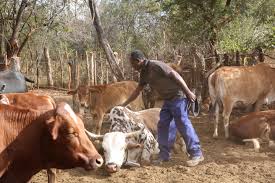HOW TO START CATTLE & SHEEP FARMING SUCCESSFUL NOW?



CATTLE FARMING
Beef farming slots in well with other agriculture enterprises, especially grain. Cattle can feed on resources that have little other use, such as crop residue and land not suitable for crops.
Before entering the cattle business, though, you should consider your resources, the land available and your level of interest and skill. You should know why you want to rear cattle, and be able to set yourself goals to achieve the most constant economic return or personal satisfaction.
A small-scale cattle enterprise can involve a growing and feeding system (calves or weaners are either raised or bought and then fattened for slaughter), breeding herds, or a combination of growing, feeding and breeding herds.
Growing/ Feeding
In a weaner operation you acquire calves after weaning at 10 to 15 months of age. They can then be fed and marketed in less than a year from the time of purchase. Thus, the investment on each calf is returned within a comparatively short time. This type of operation not require much land, but you will need adequate facilities to keep the animals comfortable and under control. Working with calves requires a good deal of patience, as they are easily excited and stressed, and a health program should be discussed with a vet.
Commercial or Registered?
Establishing a breeding herd is a long-term objective. You need to decide whether to run commercial cattle or registered purebred cattle. Income from a commercial beef herd comes mainly from the sale of calves and old or cull animals, whereas income from registered cattle comes mostly from sale of breeding stock.
Breeding registered cattle to supply breeding animals to other cattle producers usually needs a large capital investment in stock. You also will have to keep accurate records and register the purebred calves retained for breeding stock.
SHEEP FARMING



Sheep husbandry is mainly practiced in the Eastern Cape, Northern Cape, Free State and Mpumalanga, with the other provinces having smaller numbers. The domestic sheep is produced for its wool, meat and milk. Other byproducts are:-
- Clothes, footwear, rugs, and other products are made from sheepskin.
- Sheep tallow can be used in candle and soap making.
- Sheep droppings, which are high in cellulose, have even been sterilized and mixed with traditional pulp materials to make paper.
- Of all sheep byproducts, the most valuable is lanolin: the water proof, fatty substance found naturally in sheep’s wool and use as a base for innumerable cosmetics and other products.
Small can be profitable
A small sheep farming operation calls for dedication, discipline and a genuine concern for the animals. Sheep farming is not simply about numbers. A small number of well-managed, productive animals may make you more money than a larger number of animals on poor condition.
GENERAL
Inoculation
It is crucial to follow a proper inoculation and dosing program. Keep record of the dates of dosing or inoculation and the quantity used on each sheep.
Hooves
Trim the animal’s hooves regularly, especially if they have to walk long distances to and from grazing.
Clean Wool
To ensure good clip prices, keep the wool on the sheep free from thorns and grass seed.
Keep Records
In addition to keeping records of inoculations, newborn lambs, the sale of ewes and so on, it is extremely important to keep proper records of expenses and income to determine the profitability of the operation. Without this, you cannot run a business successfully.
IF YOU NEED HELP IN ANY OF THESE AREAS OR A PROFESSIONAL FARMING BUSINESS PLAN CONTACT US NOW: (27) 84 583 3143 or email us at: money@global.co.za
HOW TO START CATTLE & SHEEP FARMING SUCCESSFUL NOW? Read More »